Life
Military career
The son of the squire François Fiacre Guinement, seigneur de Keralio and of Marguerite Rose Bodin, Auguste entered the military academy in the citadel at Metz on 15 June 1732, aged just 17. He was made a lieutenant in the Carhaix battalion of the Brittany militia on 1 August 1733. He stayed in it until 8 February 1734, when he joined the régiment d'infanterie d'Anjou, in which his elder brother Felix François Guinement lost his life whilst serving as a lieutenant at the Siege of Philippsbourg on 18 July 1734.
Auguste saw action in the War of the Polish Succession - in May 1734 served at the battle at Colorno. He also fought at San Pietro before his regiment was sent to relieve the bataillon du Dauphin, then blockaded by Imperial forces at Secchia (18 September 1734). He fought at Guastalla on 21 September, where one of his contemporaries from the Metz military school, lieutenant Charles de Pagès, was seriously wounded. After the capture of Mirandole, Keralio was sent into winter quarters at San Secondo in the Duchy of Parma.
In 1735 he took part in the capture of the castles at Gonazgue, Reggiolo and Revere, for which he was made an aide-major on 29 August that year. He returned to France in September 1736. On 13 January 1741 he was made a captain and put in command of a company of the 2nd battalion of the régiment d'Anjou, fighting with them in the Bohemian theatre of the War of the Austrian Succession. As a capitaine aide-major, he was second-in-command to the regiment's colonel, the marquis d'Armentières, at Egra in June 1742, during the Siege of Prague. In 1747 de Belle-Ile put de Keralio in command of the Fourrages army depot in Marseille. In 1749 he left the army, but at the request of Louise-Élisabeth was later given the rank of 'colonel réformé' in 1757.
Under-governor to Ferdinand of Parma
In 1754 he was made preceptor to the young count of Gisors, de Belle-Isle's son, and accompanied him on his Grand Tour of Europe. During this he met Frederick II of Prussia, Maria Theresa I, Empress of Hungary, George II of Great Britain and many other monarchs. In 1756 he became secretary to his close friend the Duke of Nivernais during the latter's embassy to the King of Prussia.
He was made an honorary member of the Academy of Fine Arts of Parma on its creation in 1757, writing to it from Paris. That year also saw the Duke of Nivernais recommending de Keralio to Louis XV as one of the three under-governors to Louis de France or as sub-governor to the infant Ferdinand, Duke of Parma. He and abbé Condillac were put in charge of Ferdinand's education from 8 March 1757 to 1769, teaching him philosophical ideas, putting intelligence and understanding at the centre of his education and attempting to mould him as a philosopher-king. Surrounded by the clergy of Parma and representatives of the Austrian court, Ferdinand was unable to put his knowledge and education into practice.
On his return to France, he was granted a pension of 10,000 livres by Louis XVI, a pension of 10,000 reales billon by Charles III of Spain on the commandery of Onda belonging to the Order of Montesa and an apartment in the palais du Luxembourg, where he became a neighbour of the future Louis XVIII. From 1769 until his death de Keralio divided his time between his apartment and the hôtel de Tournon, residence of the Duke of Nivernais. He regularly helped Condorcet translate mathematical texts and became his secretary between 1770 and 1780. De Keralio was imprisoned for several months during the Reign of Terror and was only saved from the guillotine by the intervention of his niece Louise-Félicité de Kéralio. He died in Paris in 1805 aged 90.
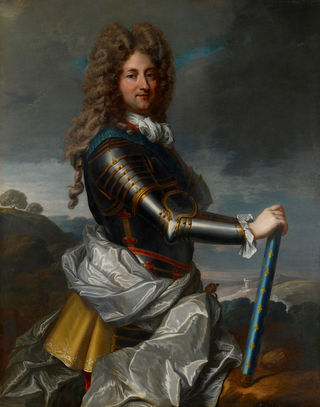
Philippe II, Duke of Orléans, was a French prince, soldier, and statesman who served as Regent of the Kingdom of France from 1715 to 1723. He is referred to in French as le Régent. He was the son of Monsieur Philippe I, Duke of Orleans, and Madame Elisabeth Charlotte, Duchess of Orléans. Born at his father's palace at Saint-Cloud, he was known from birth by the title of Duke of Chartres.

The Régence was the period in French history between 1715 and 1723 when King Louis XV was considered a minor and the country was instead governed by Philippe II, Duke of Orléans as prince regent.

Louis Jules Mancini, 4th Duke of Nevers was a French diplomat and writer.
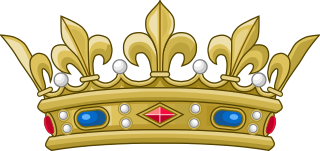
Fils de France was the style and rank held by the sons of the kings and dauphins of France. A daughter was known as a fille de France.
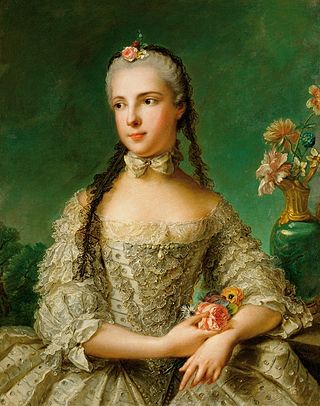
Isabella of Bourbon-Parma was a princess of Parma and infanta of Spain from the House of Bourbon-Parma as the daughter of Philip, Duke of Parma and Louise-Élisabeth of France. She became an archduchess of Austria and crown princess of Bohemia and Hungary in 1760 by her marriage to Archduke Joseph of Austria, the future Joseph II, Holy Roman Emperor.

Philip Joseph, Prince of Salm-Kyrburg (1709–1779) was the first prince of Salm-Kyrburg, from 1743 to 1779.
Louis-Félix Guinement, chevalier de Kéralio was a French soldier, writer and academic. He married Françoise Abeille and their daughter was the feminist writer Louise-Félicité de Kéralio.

Louis-Guy de Guérapin de Vauréal, also Louis-Gui de Guérapin de Vauréal or Louis Guy Guerrapin de Vauréal, Baron de Vauréal et Comte de Belleval,, was a French aristocrat, ecclesiastic and diplomat.

Louise-Élisabeth of France was a French princess, a fille de France. She was the eldest daughter of King Louis XV and Queen Maria Leszczyńska, and the twin sister of Henriette of France, and she was the only one of his legitimate daughters who married. She married Infante Philip of Spain, who inherited the Duchy of Parma and Piacenza through his mother in 1748. Infante Philip was her father's first cousin; both men were grandsons of Louis, Grand Dauphin. Thereafter, Élisabeth and her husband founded the House of Bourbon-Parma. She functioned as the de facto ruler of the Duchy of Parma between 1748 and 1759.
Charles-Antoine Leclerc de La Bruère was an 18th-century French historian and diplomat.

Charles, duc de Fitz-James was a French general and 4th Duke of Fitz-James, who descended from the British House of Stuart. He rose to become a peer and Marshal of France.
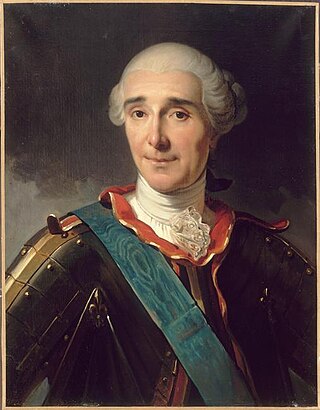
Guy Michel de Durfort, 2nd Duke of Lorges was a French general and nobleman. He was duke of Lorges and duke of Randan and was made a marshal of France in 1768.
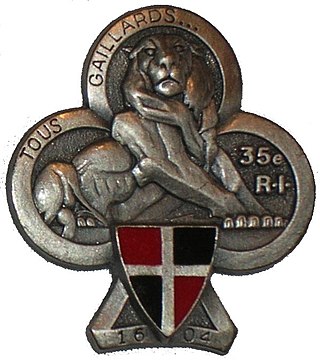
35th Infantry Regiment is an infantry regiment of the French Army. Its origins date back to the formation of the régiment de Nemond in 1604 by a member of the gentry from Lorraine whose surname was Némond. During World War I it was nicknamed As de Trèfle. It is now based at the garrison in Belfort.

Étienne-Charles, Duke of Damas-Crux was a French soldier and politician.
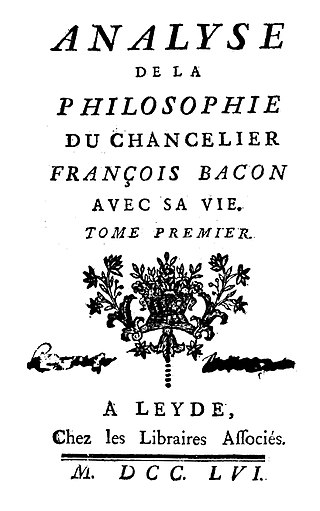
Alexandre Deleyre was an 18th-century French man of letters and translator from Latin. He was a friend of J.J. Rousseau, who used his translations of Lucretius for compositions.
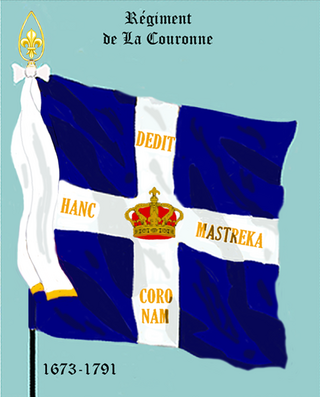
The Régiment de La Couronne was an infantry regiment of the Kingdom of France, created in 1643.
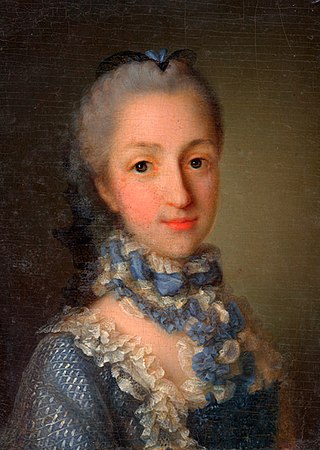
Françoise de Chalus, was a French noblewoman and courtier. She was the mother of Louis, comte de Narbonne-Lara, possibly by king Louis XV of France. She was the lady-in-waiting of Louise Élisabeth of France in 1749–59, and the influential favorite lady-in-waiting of Princess Marie Adélaïde of France in 1764–1800.

The House of Rohan-Chabot is a French noble family. It was established as a result of the marriage in 1645 between Henri Chabot and Marguerite de Rohan, the sole heir of the Duchy of Rohan. The Rohan-Chabot family is the eldest branch of the House of Chabot, a French noble family originally from Poitou.
Louis Marie Fouquet, Count of Gisors was a French nobleman and soldier. He was born in Metz, the only child of the Duke of Belle-Isle, a distinguished general, and his second wife Marie Casimire de Béthune. He was awarded the title Count of Gisors. He was admitted to the Knights Hospitaller as a child, but never took his vows because of his age, so allowing him to marry later.
This page is based on this
Wikipedia article Text is available under the
CC BY-SA 4.0 license; additional terms may apply.
Images, videos and audio are available under their respective licenses.















